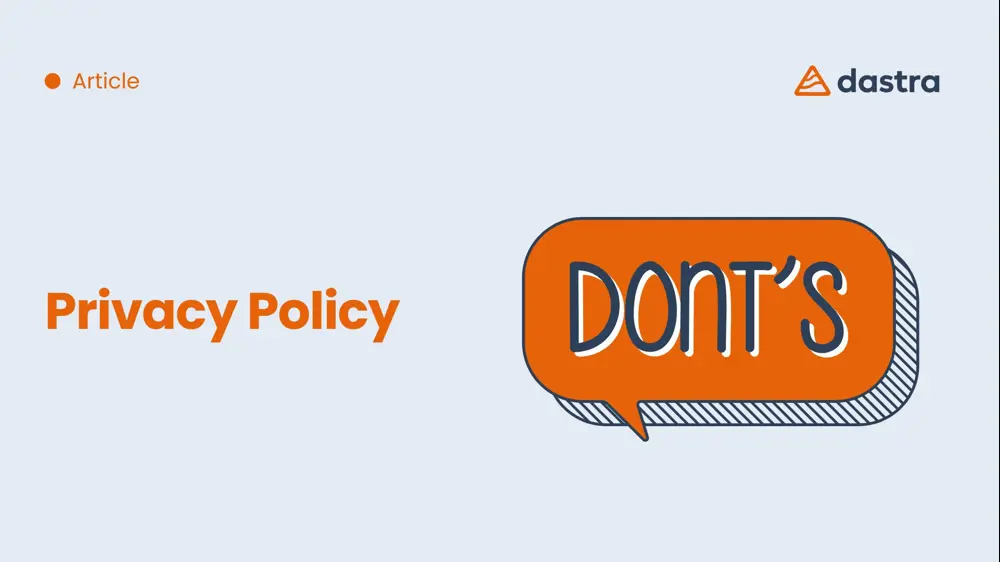A privacy policy is a crucial document that outlines how an organization collects, uses, and safeguards personal data. It also informs users about their rights concerning their information and the ways in which their data may be shared.
To ensure compliance with the General Data Protection Regulation (GDPR), it's imperative that the privacy policy meets all legal requirements to avoid substantial penalties.
However, organizations often make certain mistakes that can compromise the transparency and compliance of their privacy policies.
Below are seven common mistakes to avoid, along with tips for developing a compliant policy, as advised by GDPR experts from Dastra:
1. Omitting essential information
Some organizations neglect to include critical details in their privacy policies, such as the identity of the data controller and/or processors, data recipients, purposes of data processing, user's rights, data retention periods, and international data transfers.
The absence of these elements can lead to non-compliance with GDPR regulations, erode user trust, and result in significant fines.
Tips
Regularly update the privacy policy to reflect any changes in data processing practices, including retention periods.
Utilize a standard template that encompasses all elements required by the GDPR.
Clearly articulate your commitments to personal data protection and detail the technical and organizational measures implemented to secure user information.
2. Lack of transparency
A privacy policy must be written in clear, accessible language to ensure users understand how their personal data is handled. Using complex legal or technical jargon can hinder comprehension, violating the transparency requirements of the GDPR.
According to Article 12 of the GDPR, the information must be presented in a concise, transparent, understandable, and easily accessible manner.
Tips
Use simple language and avoid technical terms.
Organize information logically with clear headings.
Provide concrete examples to clarify complex points.
3. Non-compliance with User Rights
The GDPR grants users specific rights, such as the right of access, rectification, erasure, objection, and the right to data portability.
A common mistake is omitting these rights in the privacy policy or failing to provide clear instructions on how users can exercise them.
The absence of contact information or specific procedures for submitting requests can lead to non-compliance.
Tips
Include a dedicated section detailing each user right.
Provide clear instructions and contact information, such as an email address, for submitting requests.
4. Deficiencies in consent mechanisms
Consent mechanisms are often mismanaged.
Common pitfalls include failing to inform users of their right to withdraw consent at any time and not distinguishing between different purposes of data processing
Tips
- Ensure that consent is obtained clearly and distinctly for each specific purpose.
- Clearly inform your users of their right to withdraw their consent at any time and explain precisely how they can do so.
5. Lack of updates
Privacy policies are often written once and then neglected.
When business practices or legal requirements change, these changes are not reflected in the policy, making it outdated and potentially non-compliant with the new data processing terms.
Tips
- Establish a periodic review process for the privacy policy to incorporate changes in practices and regulations.
- Inform users of any updates and ensure the revised policy is easily accessible.
6. Lack of coordination with cookie policies
Privacy policies and cookie policies should be harmonized to avoid any inconsistency.
It is common for these two documents to be treated separately without proper alignment. But discrepancies between these documents can confuse users and lead to compliance issues.
Tips
- Ensure that the privacy policy references the cookie policy and vice versa.
- Verify that information regarding user tracking through cookies and other technologies is consistent across both policies.
7. Generic and non-tailored policy
Using a generic privacy policy without tailoring it to the organization's specific data processing activities can result in non-compliance.
Tips:
Customize the privacy policy to reflect the types of data collected, processing methods, and the organization's specific practices.
Consult data protection experts to develop a policy that accurately represents your organization's data handling procedures.
